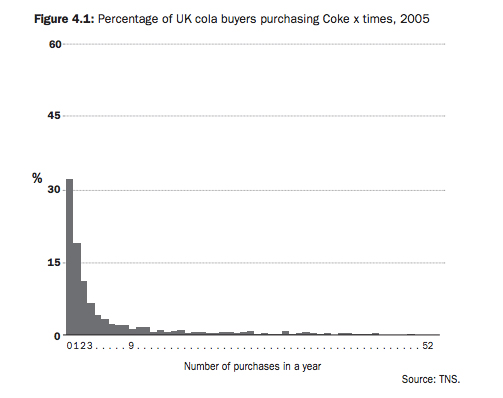For too long, our image of music fandom has clung to the romanticised vision of ‘70s groupies or the “Band-Aids” of Almost Famous. But it’s time to face the music: the way fans consume has fundamentally changed, and today’s streaming-first culture demands a modern approach to music marketing.
Bryon Sharp – How Brands Grow
The ideas of Byron Sharp—author of How Brands Grow—have transformed the marketing world since the book’s release in 2010. Sharp’s data-driven insights call into question long-held beliefs about brand growth and loyalty, and these ideas are no less applicable to the world of music, where today’s fans stream songs rather than pledge allegiance to artists. In this piece, Right Chord Music’s Mark Knight explores how Sharp’s lessons for brand growth may be the wake-up call music marketers need to embrace in a post-ownership, streaming-dominated landscape.
From Artists to Songs: The Changing Face of Music Consumption
In recent decades, music consumption has shifted from physical ownership to digital access. The rise of streaming services has not only changed the medium but also our connection to music itself. No longer are fans queuing outside record stores or pouring over sleeve notes for insights into the artists’ creative process. Today’s fans carry a world of music in their pockets, streaming songs on-demand and, all too often, without necessarily knowing (or caring) about the artist behind them.
Spotify data tells us that people now listen to 30 to 100 times more individual tracks than artists each year. While this exponential access means that more artists can reach listeners, it’s becoming harder to cultivate the dedicated, repeat listeners of old. Music lovers are sampling an ever-wider array of songs and artists, leaving fandom spread thin.
If you’ve ever been surprised by your Spotify Wrapped playlist, the reason may be simple: the difference between your top five and top 100 songs could be as little as a handful of extra plays. Byron Sharp’s research draws a stark conclusion:
- Brands grow by reaching more buyers, not by fostering loyalty.
- Market penetration, not loyalty, is the secret to sustainable growth.
- Loyalty programs rarely yield significant growth.
In music, we’ve long believed that success depends on building and nurturing a fanbase, creating loyal fans who will stick with us for the journey. But is it time to shift that thinking? In the age of Spotify, should our focus be on winning the next listener instead?
Sharp’s findings indicate that the benefits of customer acquisition often far outweigh the returns on building loyalty. It’s simply easier to persuade someone new to buy once than to secure a repeat purchase. Coca-Cola illustrates this well: while the average Coke consumer is thought to buy 12 times per year, in reality, most buyers purchase only once or twice annually. The average is skewed by a few heavy users. For Coca-Cola, a “heavy” buyer is anyone who purchases three or more times a year—an incredibly low threshold by brand standards.

What if we apply this to music? Think of Taylor Swift as the Coca-Cola of pop. Her fan base may include dedicated “Swifties” who stream her music non-stop, but her true success lies in her reach: a staggering number of casual listeners who might play a song or two but are unlikely to binge on her back catalogue. For Swift, those additional plays from light listeners add up to a mammoth reach, even if superfans drive the headlines.
Sharp’s principle of ‘Buyer Moderation’ suggests that consumer behaviour, even in its extremes, tends to moderate over time. In other words, this year’s superfan may not be next year’s, and music marketers would do well to bear this in mind.
Music Marketing for the Modern Age: Three Principles
- Don’t Over-Index on Superfans
While superfans may be a vocal and engaged minority, they aren’t always dependable. Spending disproportionate time or resources on them can limit your ability to capture a broader audience. Their engagement is likely to moderate over time. - Focus on Acquisition and Reach
Artists should aim to connect with a wide and diverse range of listeners, including light listeners and potential new fans, instead of relying on heavy users alone. As today’s superfans inevitably drift, a robust acquisition strategy ensures that fresh listeners replace them. - Leverage Incremental Reach
Even a single additional stream or playlist inclusion can increase an artist’s visibility. Embrace opportunities to gain a light listener here or there. Over time, it’s this incremental reach that will propel artist growth.
In an era where fans are more likely to add a song to a playlist than join a fan club, it’s time for the music industry to tune into Sharp’s lessons. If music marketers want to grow in the streaming age, they’ll need to shift the focus from loyalty to reach—because the next listener is just one click away.
Discover more on Right Chord Music
- The Musician’s Census 2024: “It’s Becoming Harder To Be An Independent Artist.”
- Music Promotion: Nobody Cares About Your Music (As Much As You Do)
- Unsigned Bands: Should Stop Wasting Money On Radio Pluggers
- Anna Wolf Soundtracks The Escape From Toxicity On ‘FREE’
Words Mark Knight






